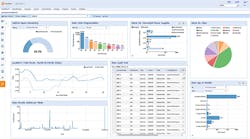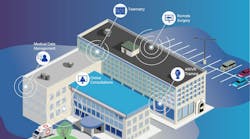In this week’s Voices of the Industry, Herman Chan, President of Sunbird Software, explores the top dashboards and KPIs that help every modern data center boost productivity and efficiency.
Driven by emerging technology and business trends like IoT, big data, and digitalization, the modern data center is evolving infrastructures and management practices to comply with environmental regulations, accelerate time to deployment, and address other key objectives.
Herman Chan, President, Sunbird Software
Under pressure to do even more with less, modern data center managers and operators are turning to data and analytics to provide the information needed to optimize their data centers. Smart devices such as intelligent rack PDUs enable the collection of an abundance of sensor and polling data from a wide range of sources. But with this volume and variety of data, how do you identify the useful data, analyze what this data actually means for your data center, and turn this information into actionable insights?
Operators are turning to data and analytics to provide the information needed to optimize their data centers.
That’s where dashboards can make a difference. Having a focused dashboard with a few key metrics for each of your top objectives or organization-specific initiatives accelerates data analysis and reduces distractions by displaying only the key data that you need for that particular goal. Teams know to go to their dashboard for the latest information, and they know that everyone can see the same data, which boosts transparency and accountability.
Which metrics should you track on your dashboards? The most useful Key Performance Indicators (KPIs) will vary based on your objectives and the questions that you need to answer. However, based on our experience with helping customers determine which data matters most, these six dashboards and their associated KPIs are most critical to successfully managing today’s modern data center.
1. Space
Space can be one of your biggest limitations when managing your data center. A dedicated dashboard will help you ensure that you’re making the most of the space that you have so you can avoid costly investments in new data centers or hybrid environments, unless absolutely necessary. In addition to the floor and cabinet space remaining, consider tracking contiguous space and cabinet utilization. Chassis slot usage, RUs used by rail (front, back, or both), and RU capacity trends are often-overlooked but important metrics that can derail your space planning if ignored.
[clickToTweet tweet=”Space can be one of your biggest limitations when managing your data center.” quote=”Space can be one of your biggest limitations when managing your data center.”]
2. Inventory
Most data centers have a wide variety of assets, and a dashboard will give you an at-a-glance view of what you have, how much you have, and the current status of each asset so you can accurately plan for upcoming maintenance and provisioning of assets. On this dashboard, consider tracking not only the number of assets you have but also the age of these assets and if they are physical or virtual. Other suggested KPIs include items added per week, items by class and status, item cost by key item fields, and hosts and VMs per cluster.
3. Connectivity
Along with the assets in your data center, you need to ensure that you have enough data ports, power ports, and cabling to connect your assets in the current layout of your data center. Besides the number of open data and power ports, consider tracking cabinets with the most available power and data ports, data port usage per connector, number of power circuits added per week, and data and power port capacity trends.
Most data centers have a wide variety of assets, and a dashboard will give you an at-a-glance view.
4. Change
A change management dashboard may seem unnecessary, but keeping track of the moves/adds/changes helps you ensure that your workflow processes are effective and that your requests are being fulfilled at the appropriate pace. In addition to the number of requests and their stages of completion, consider tracking completed requests by location, type, and user. Look at completed requests by timeline as well to ensure that your changes are being completed promptly.
5. Environment
Environmental monitoring isn’t just a matter of meeting regulations; data center operators need to make sure their equipment is operating within manufacturer or ASHRAE guidelines to avoid costly damage and overcooling. Consider tracking temperature with the ΔT and humidity with the ΔH per cabinet as well as the number of devices with instrumented sensors.
Pro tip: You will generate better data if your data center has an adequate number of temperature and humidity sensors appropriately located in the cabinets (top, middle, and bottom) and aisles (hot or cold).
6. Power
Keeping track of how much power you are consuming and how much is available is foundational to the efficiency of any data center, but many data center managers don’t look beyond total actual active power and budgeted power capacity remaining. Trending power capacity can help you forecast more accurately, while tracking actual power by customer cabinets and a location’s total power month to month can help you manage customer billback and energy usage more accurately.
A Single Source of Truth with DCIM
Of course, creating these dashboards and identifying the appropriate data sources is easier said than done. In fact, most data center professionals already have dashboards—but each dashboard typically pulls data from a separate system or spreadsheet. Storing data across multiple, disparate sources without easy integration hinders your ability to manage your data center’s performance effectively. The knowledge you rely on is limited, untrustworthy, or rapidly becomes out of date, which means that your plans may be based on faulty data or that you may need to travel to the data center to verify your information in person. Data in isolation also has limited utility.
A comprehensive Data Center Infrastructure Management (DCIM) solution addresses these concerns by providing a single source for all of your data center data. With all of your data updated and visible in real time in a single-pane-of-glass view, it’s easier to identify and eliminate inefficiencies, like stranded capacity and overprovisioning, and to avoid unexpected expenses and overcharging.
Bringing It All Together
Today’s data center managers and operators have an abundance of data at their fingertips. Identifying the data that is useful and categorizing that data into dashboards based on your objectives is just the first step to maximizing the value of your data.
This article is not intended to be an all-encompassing list of DCIM KPIs; rather, it serves as a starting point and guide for organizations looking to make sure they are tracking the most meaningful metrics for optimizing their data centers.
To figure out what the data actually means for your data center and to act on your insights, the next step is to take your data out of isolation and into a DCIM or similar system that allows you to rapidly analyze it. Once you’re able to make meaningful, cross-category connections among your data, you’ll ultimately be able to make smarter decisions about the management of your data centers.
Herman Chan is President of Sunbird Software, a global company that is changing the way data centers are managed through radically simplified DCIM software. Prior to his role at Sunbird, Chan was the DCIM General Manager at Raritan, Inc., leading product management and marketing teams for over 15 years. He pioneered Raritan’s successful entry into intelligent power management, managed Raritan’s emerging data center infrastructure management (DCIM) business, and oversaw Raritan’s global marketing and product strategy. Prior to Raritan, he held management positions with Fountain Technologies and Panasonic. He can be reached at [email protected].





